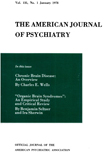A CORRELATION OF SYMBOL ORGANIZATION WITH BRAIN FUNCTION (EEG)
Abstract
My thesis is that the more related the replication is to the sense data, the lower is the order of symbolization. Consequently, irrespective of the complexity and meanings of the subject matter, as perfection in rendition is accomplished, the lower the order of symbol portrayed. In this sense the natural development of artistic forms is in non-representational geometric and surrealistic symbols. This logic induces a paradoxical situation. Are the scribbled delineations of the child, and anthropoids, high order symbols? Certainly the child's scribbles do not have representational value. This potential paradox is resolved when it can be demonstrated that the scribbling has very little, or no, second order symbol value to the child. This major point is elucidated by asking the child to point out, after the scribbling, even if he has named anatomical parts during the production, the various components. This is hardly ever accomplished correctly, even when there is only little time delay from the scribble to the interrogation. If the time delay is long and/or the picture rotated, the child cannot point out the body parts he has named in his scribbled display, but he can easily do this from a conventional two-dimensional manikin. As a consequence it appears that the scribble constitutes a mark without particulate, or general, symbolic value.
Further evidence that the picture drawing is an individual symbol of a person, and not necessarily a representation of the body image concept, is the fact that irrespective of the vicissitudes of brain function, in general, the major elements are faithfully reproduced, even when the composition is unilaterally or generally disturbed.
The specific, asymmetric distortions are a further point in favor of this concept. It seems very clear that these distortions when present are a manifestation of a disturbance in the instrumentalities; that is, the visual field is lost to the individual and consequently he displaces the elements in the blind field. A fruitful study might be the attempt to discover why some individuals with visual field defects do NOT portray asymmetric picture drawings.
It is of course, possible to discuss the presented data in the fabric of the body image concept, and its distortions. This, however, implies a one-to-one correspondence between the depictions and the body image concept. From my material, this direct correspondence is difficult to demonstrate. However, if material such as that comprising Figure 2 could be amplified and confirmed, the direct relation between body image concept and depiction might be demonstrated. Irrespective, it is quite clear that the body image concept and the body depiction complex is not a process of physiological proprioception in the sense of spatial orientation of body parts. This derives from the fact that the blind child between the ages of 7 and 8 years (personal observations) is unable to present compositionally correct graphic or plastic forms of the human figure. As a consequence it appears that the graphically depicted human form is in high probability a visually learned and controlled symbol operation with only occasional perturbatory accretions emanating from volitional or non-volitional expressions of annoying parts or conflictual feelings. Consequently, a direct operational approach through symbols has been emphasized and employed in this study of the portrayal of the human figure.
In conclusion, it is shown that by means of learned processes, basic symbols are formed that appear to be a conservative expression of a person. An attempt has been made to demonstrate that this symbol fluctuates in a representational (second order) and non-representational (higher order) behavior matrix. And finally, that in the presence of crippling lesions of the brain, either of a transient, or more fixed type, that the symbol is either distorted in part or in a general manner, depending on the nature of the brain lesion.
Access content
To read the fulltext, please use one of the options below to sign in or purchase access.- Personal login
- Institutional Login
- Sign in via OpenAthens
- Register for access
-
Please login/register if you wish to pair your device and check access availability.
Not a subscriber?
PsychiatryOnline subscription options offer access to the DSM-5 library, books, journals, CME, and patient resources. This all-in-one virtual library provides psychiatrists and mental health professionals with key resources for diagnosis, treatment, research, and professional development.
Need more help? PsychiatryOnline Customer Service may be reached by emailing [email protected] or by calling 800-368-5777 (in the U.S.) or 703-907-7322 (outside the U.S.).



